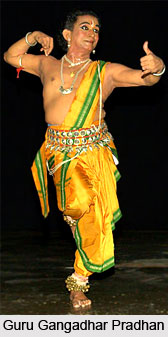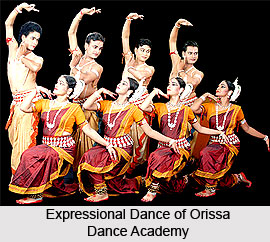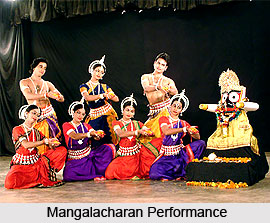 Orissa Dance Academy organises persistent training classes both for Indian and foreign students to project and popularise Odissi Dance in the country and also abroad. A leading institution in Bhubaneswar, Orissa Dance Academy was founded in 1975 and strictly aims to foster Orissan art and cultural heritage through proper and rigorous training.
Orissa Dance Academy organises persistent training classes both for Indian and foreign students to project and popularise Odissi Dance in the country and also abroad. A leading institution in Bhubaneswar, Orissa Dance Academy was founded in 1975 and strictly aims to foster Orissan art and cultural heritage through proper and rigorous training.
Orissa Dance Academy offers ample opportunities for the Odissi dancers to perform on stage. The academy has two sections, one for teaching and other for training. Guru Gangadhar Pradhan, the eminent Odissi Dance exponent and Sj. Dhirendra Nath Patnaik, the eminent scholar founded this institution. Guru Gangadhar Pradhan, who is one of the foremost exponents of Odissi Dance, at the tender age of six, received his training as Gotipua Dancer. After finishing his Natya Acharya in Odissi from Utkal Sangeet Mahavidyalaya under proficient guidance of Guru Pankaj Charan Das, Dr. Minati Mishra and Guru Deb Prasad Das; he also received rigorous training from Guru Kelu Charan Mohapatra. Apart from mastering the delicate nuances and the subtleties of Odissi dancing, he is also a maestro of Mardala player. He is also a recipient of the State Sangeet Natak Akademi Award in 1993, the Central Sangeet Natak Akademi Award in 1998 and the prestigious Padmashree award from President of India in 2008.
This academy has made major contributions in projecting and popularising Odissi dance and music, as well as offering intensive training to artistes residing both in India and abroad. It maintains a close association with several cultural institutions in India and other foreign countries. Upholding a rich cultural heritage, the Orissa Dance Academy has moved ahead with its dignified and dynamic mission to hold many artistes into its cultural realm. Through its comprehensive activities, the Orissa Dance Academy aims at international cultural peace and accord.
Orissa Dance Academy is a unique institution for dance where the studios are never silent and the students are practicing for almost round the clock. Training classes conducted by reputed and experienced gurus (teachers), reflect the organised nature of the curriculum. The institution also organises cultural evenings, like Odissi Sandhya and Annual festival of dance and music every year at various places within India and also abroad. The most noteworthy milestone of Orissa Dance Academy is Konark Dance and Music Festival that started in 1986, which was cultivated by Orissa Dance Academy till 2008. This academy brought the imbued a true festive spirit by organising important cultural festivals for the first time in later part of 1980s. Orissa Dance Academy also organises `Dhauli Mahotsav` at Shanti Vihar, foothills of Dhauli, Bhubaneswar from 12th to 14th December every year to create cultural awareness among the people. However, another vital feature of the cultural calendar is the Annual Festival in San Diego that is celebrated in collaboration with the Centre for World Music.

The technique of learning adopted at Orissa Dance Academy is completely different from the usual method followed in most traditional dancing institutes in India. Based on the Gurukul Parampara of medieval India, the pupils in Orissa Dance Academy learn the art through perseverance, devotion, willpower and deep admiration for the teachers. Knowledge is thought to be a legacy that is handed over from generation to generation as priceless heirloom. The average training span is of ten years, with the program including both theoretical and practical on the technique of Odissi Dance.
The faculty of Orissa Dance Academy comprises teachers who work insistently under the expert guidance of Guru Gangadhar Pradhan, Guru Aruna Mohanty and Guru Manorajan Pradhan. To provide a learning environment, the maestros of Odissi dance, music and other classical art forms conduct lecture demonstrations, workshops and seminars regularly. Students are given unlimited opportunities to display their potential through stage shows. Summer classes are also organised for further training of Odissi dancing techniques. Schedules are specially planned for students coming from abroad and their comfort timings are kept in mind. Orissa Dance Academy is undoubtedly a multi-faceted training module that sternly looks into the overall development of the pupils. The usual syllabus of the Odissi dance repertoire in Orissa Dance Academy consists of 10 years. Thus, the academy has 10 different batches from Sub Junior to 8th Year. There are two classes in a week for each batch and the duration of each class is about two hours. The Academy has been organising Annual Dance Festival every year in May, thus giving facilities to all the students from the Sub Junior to senior levels, as an opportunity to perform before the audience.
To hone the skill of the students, the Orissa Dance Academy provides continuous special classes during summer vacations. The time duration is usually from 15th May to 16th June of every year. Apart from the basic students learning new items according to their respective levels of experience, there are also many senior dancers flaunting their creativity and expertise. For the students coming from abroad, the academy organises summer classes till the end of August. One interesting facet of this academy is the advanced practice lessons for the teachers. This is a five hours practice class incorporating stretching up exercises, Yoga and basic technique. The Odissi repertoires are practiced and teaching methods are continually developed through discussion and interaction with well known Gurus and dancers.
There are two performing units of Orissa Dance Academy, namely the Senior Performing Unit that works under the guidance of Guru Gangadhar Pradhan and Guru Aruna Mohanty, learning new choreographies and performing group rehearsals for different productions and programmes. On the other hand, the classes of Junior Performing Unit are held for five days a week and three hours each day.
 The students practice to perfect their skills and present solo and group performances at the state and national levels. At this junior stage, factors like personality development, good communication skill, interpretation of literature are given due importance. The over all development of an artiste is incorporated through music and rhythm sense.
The students practice to perfect their skills and present solo and group performances at the state and national levels. At this junior stage, factors like personality development, good communication skill, interpretation of literature are given due importance. The over all development of an artiste is incorporated through music and rhythm sense.
Many short courses are offered at different times of the year by the faculties of Orissa Dance Academy to accommodate the need and requirement of the students, who come from different parts of India. As per their requirement and the evaluation of the expert committee, the teachers are specially allotted to work with those students. With individual lessons sometimes the students are encouraged to attend group classes. The courses are designed according to the time frame specified by the student. Not only the institution takes care of the professional needs, but Orissa Dance Academy also looks after the social needs of their students to make them feel at home. One of the well-known dance institutions in India, Orissa Dance Academy has gained immense popularity in foreign countries as well.
The Orissa Dance Academy is located at Qr. No. 4R-8 Unit - 8 Infront of OUAT Guest House Bhubaneswar - 12 C.



















